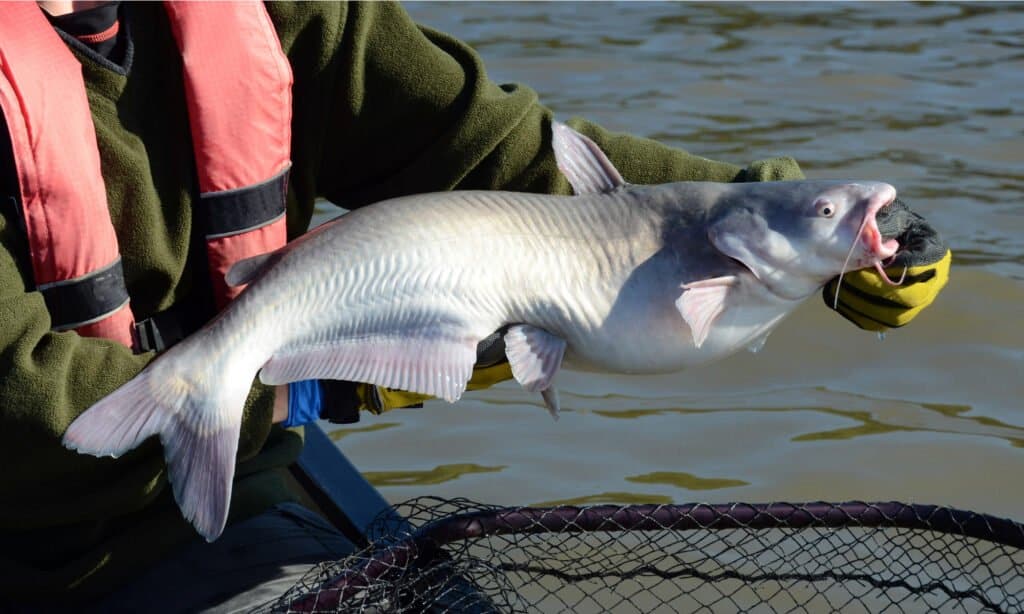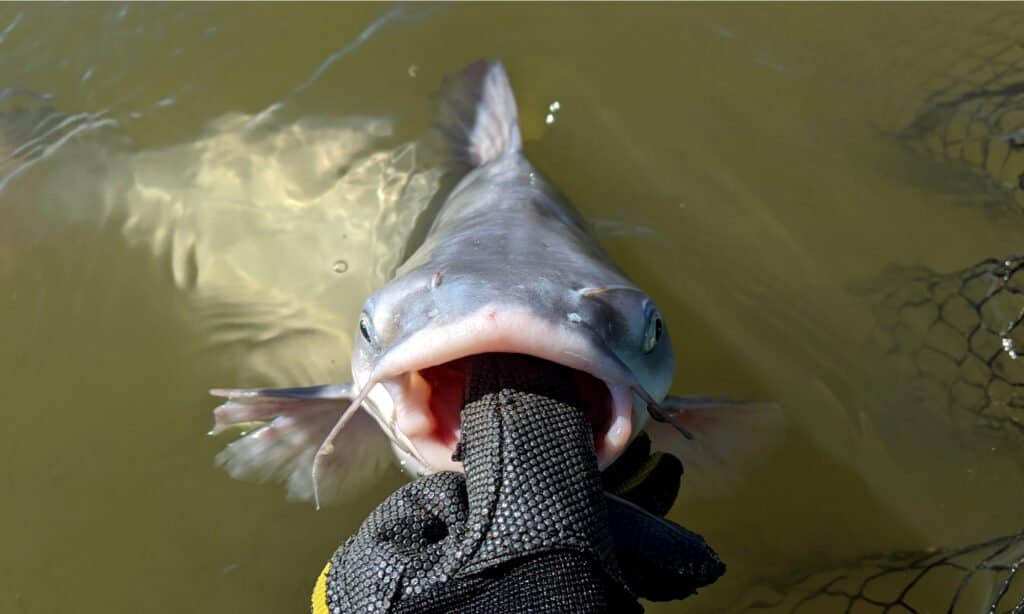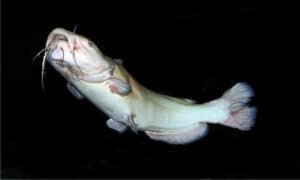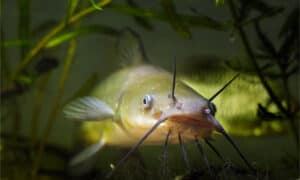Colorado is best known for its rugged terrain, out-of-this-world wildlife, and the major Colorado River, but what’s it like for fishing? Let’s take a look at the largest blue catfish ever caught in Colorado and other record-breaking fish captured from its waters.
Blue Catfish: Species Overview
Blue catfish (Ictalurus furcatus) are North America’s largest catfish. Due to their size, they have very few predators and a large appetite for other fish! Blueys are invasive in the Chesapeake Bay because they take such a toll on other fish species but are native to the Mississippi River basin.
Anglers enjoy hunting blue catfish because they reach such epic proportions and put up a strong fight. But what do we mean by epic proportions?

Blue catfish are not actually blue but slate-gray with a hint of blue.
©M Huston/Shutterstock.com
Blue Catfish Expected Size
These massive predatory fish typically reach 20-46 inches long, and state records range between 17 and 143 pounds, so there’s a lot of variation.
Blue catfish are clever. They hide near submerged objects and tend to hunt at night. This means they can avoid capture for years and grow to huge sizes.
The average weight is 10-20 pounds and about two feet long. Blue catfish become trophy material in the United States when they reach around 50 pounds in weight.
Appearance
Blue catfish are not actually blue but slate-gray with a hint of blue. The Rio Grande blue catfish has side and back spots.
They are hefty fish with a dorsal lump, protruding lower jaw, and a square forked tail. All catfish have barbels (whiskers), hence the name “cat” fish (and yes, there are dogfish, too!). Blueys have four sets of barbels to seek out prey as they swim along lake and reservoir bottoms.
Blue catfish look very similar to the more common channel catfish, and it’s an easy mistake to make, especially if their coloring is on the dark side. A foolproof method is counting the number of rays on the anal fin. Blueys have 30-36, but channel catfish only have 25-29.
Habitats
These large predatory fish are native to the Mississippi River basins that drain into the Rio Grande, Missouri, Arkansas, Ohio, and Tennessee River basins. They’ve been introduced to most states as sport fish, and their tolerance of brackish water means they’ve spread into many waterways.
Their range now stretches from Minnesota to northern Guatemala. Virginia and North Carolina, in particular, have very high blue catfish populations. The world record blue catfish was actually caught in Virginia.
However, in Virginia and around the Chesapeake Bay, they’re considered invasive and a threat to native ecosystems. For example, in the Chesapeake Bay, blue catfish have decimated blue crab, striped bass, and Atlantic sturgeon numbers.
Blue catfish live in deep water, so they usually inhabit large rivers and reservoirs. They keep to river beds and bottoms in the gravel and sand near submerged objects they use for camouflage and safety.
Diet
Blue catfish are opportunistic predators that will eat pretty much anything dead or alive in the water. Adults eat crawfish, mussels, frogs, and other fish species, including catfish. Juveniles eat insects and larvae before moving on to small, live fish.
Popular feeding spots include next to dam spillways and power turbines that wound baitfish and beneath schools of striped bass.
Blueys are one of the very few fish that can eat invasive Asian carp (others are alligator gar and white sturgeon), so they are valued for that skill.
The Largest Blue Catfish Ever Caught in Colorado
The largest blue catfish ever caught in Colorado weighed 29.13 lbs. Angler Randy Stillwell hooked it in the Pueblo Reservoir (Pueblo County) in 2019. The massive blue catfish was 38.5 inches long with a 25-inch girth, verified by Colorado Parks and Wildlife officer Gretch Holschuh.
Stillwell was actually fishing for crappie that Sunday afternoon but managed to land a record-breaking bluey instead. After landing, weighing, and measuring his epic catch, Stillwell tried to release his record breaker, but it didn’t make it.
Colorado’s state record blue catfish isn’t what anglers call a whopper. Only one state has a smaller blue catfish record! The smallest state record is a 17-pound, 12-ounce blue catfish caught in Washington’s Columbia River back in 1975.

Blue catfish become trophy material in the United States when they reach around 50 pounds in weight.
©M Huston/Shutterstock.com
Large Fish Caught in Colorado
Let’s see other record-breaking catfish in Colorado.
Largest Channel Catfish
The biggest channel catfish caught there was a 43.38 lbs monster. Jessica Walton caught it in 2010 in the Aurora Reservoir.
Largest Flathead Catfish
Michael Flock caught Colorado’s largest flathead catfish in 2017 in the Pueblo Reservoir. It weighed 30.6 lbs.
And if you were wondering about the Colorado River, its all-tackle record for a blue catfish was hooked by Maurice Walker on a rod and reel on February 11, 2003. The bluey weighed 44 lbs 5 oz and was 43 inches long.
Colorado’s Largest Caught Fish
Colorado’s state record for heaviest-ever fish is a 57-lb and 47-inch long grass carp. Brian Husmann snagged this heavyweight in 2013 from Cottonwood Park Lake in Lakewood, Jefferson County.
Donald Walker hooked the second-largest fish ever caught in Colorado in 2007. He caught a 50-pound lake trout at Blue Mesa Reservoir in Gunnison County.
A 40.13 lb tiger muskie was hooked in 1994 in Quincy Reservoir, and in 2006, a 30.69 lb northern pike was captured at Stagecoach Reservoir in Routt County.
Colorado certainly has plenty of large fish in its lakes and reservoirs, but none of them compare to the largest ever blue catfish caught in the United States. That honor goes to Richard Anderson.
Largest Blue Catfish Ever Caught
Anderson holds the all-tackle world record for blue catfish. He hooked an unbelievable 143 lbs bluey in Virginia’s Kerr Lake on June 18, 2011, using a piece of chicken with a Daiwa reel. His behemoth bluey measured 57 inches long with a 44-inch girth. It’s the largest blue catfish ever caught in the United States — and the world!
Back in the 1800s, there were stories of anglers who caught blue catfish weighing over 350 lbs while fishing in the Mississippi River. Unfortunately, there aren’t any records, but if this is true, it’s the same weight as an adult panda or reindeer.
How to Catch a Blue Catfish in Colorado
Want to beat Stillwell’s 29 lbs Colorado state record? Here’s how to catch a large blue catfish!
Blue catfish live in deep water, so the trick is to find a water body that is deep. Good places include:
Adobe Creek Reservoir: 180 miles southeast of Denver, this reservoir holds the highest number of blue catfish in Colorado at the last count. It’s an irrigation storage lake with high and low levels, so a boat may be needed when levels are low. Anglers believe the next state record is waiting to be hooked here.
Aurora Reservoir near Denver: A 35-pound channel catfish was snagged here, and there are blueys too.
Pueblo Reservoir: 15 minutes west of Pueblo, the Colorado state record blue catfish and flathead catfish were snagged here.
Chatfield Reservoir: This State Park reservoir is popular with catfish anglers and regularly produces good-sized blueys.
Echo Canyon Reservoir: east of Durango, it’s not as well known, but blue catfish are hooked here. It’s a good choice if you like peace and quiet.
Choose the Right Tackle
Once you’ve chosen your closest blue catfish-stocked lake or reservoir, it’s time to sort out the tackle.
You don’t need specialized tackle to fish for blue catfish, but it should be sturdy because catfish are fighters, and they can reach some hefty proportions.
Anglers recommend a medium to heavy seven-foot rod with at least a 15-pound braided line. A braided line is stronger and less likely to break on a boat or rock edges as you try to haul that river monster in. Experts suggest 4/0 or 6/0 circle hooks best suit catfish’s wide mouths.
Blue Catfish: Best Baits
The world-record blue catfish was baited with a piece of chicken! Catfish eat almost anything, so chicken, liver, stink bait, other fish, worms, and flashy lures all work. Live bait is irresistible to catfish, but be sure to follow all laws and regulations about live bait because a record won’t stand if you break the law.
The best place to find blue catfish is in deep water next to submerged objects like logs, rocks, wrecks, and bridge supports.
They will dart into shallower water to grab prey but always retreat to deep water. This is because they don’t like dense aquatic weeds and have pretty good eyesight for movement and shapes above the waterline.
Where Is Pueblo Reservoir Located on a Map?
The fishing destination of Lake Pueblo boasts more than 4,600 acres of water, nearly 10,000 acres of land, and approximately 60 miles of shoreline. Its reputation as a “hot spot” for fishing is well-deserved, and visitors soon realize that a single day is not enough to experience all the area has to offer. In addition to its mild year-round climate and abundant sunshine, Lake Pueblo has much to offer visitors.
Here is Pueblo Reservoir on a map.
Summary: How Big Is Colorado’s Largest Blue Catfish?
The largest blue catfish ever caught in Colorado weighed 29 lbs and 13 ounces and was 38.5 inches long and 25 inches in girth. Randy Stillwell snagged it in Pueblo Reservoir in 2019.
If you want to beat his record, there are plenty more blue catfish in Colorado’s rivers and reservoirs just waiting for you.
The photo featured at the top of this post is © M Huston/Shutterstock.com
Thank you for reading! Have some feedback for us? Contact the AZ Animals editorial team.






